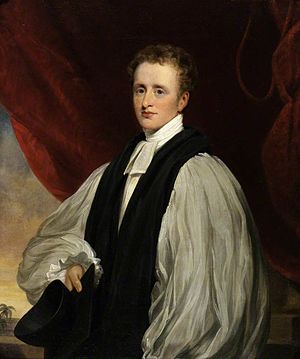History of Hymns: “God, That Madest Earth and Heaven”

Reginald Heber
God, That Madest Earth and Heaven
by Reginald Heber and Frederick Lucian Hosmer
The United Methodist Hymnal, No. 688
God, that madest earth and heaven,
darkness and light,
Who the day for toil hast given,
for rest the night:
may thine angel guards defend us,
slumber sweet thy mercy send us;
holy dreams and hopes attend us,
this livelong night.
Reginald Heber (1783–1826), a bishop of Calcutta for the Anglican Church (1823-1826), is the author of the first stanza of “God, That Madest Earth and Heaven.” Frederick Lucian Hosmer (1840–1929) is the author of the second stanza. There is an account that Bishop Heber wrote the first stanza after hearing a harp play the tune AR HYD Y NOS in a host’s home in Wales. The tune name is Welsh and translates to “the livelong night” (Young, 1993, 372).
Creation imagery is evident in the opening phrase of the first stanza. This imagery is a qualifier for giving thanks in the evening for what God has done and will do in the evening. In Heber’s stanza, some references to the book of Psalms are seen. Psalm 127:2 “It is in vain that you rise up early and go late to rest, eating the bread of anxious toil; for he gives sleep to his beloved” (NRSV) is reflected is the phrase, “who the day for toil has given, for rest the night.” The first phrase of the first stanza of the hymn also brings to mind Psalm 89:11, “The heavens are yours, the earth also is yours; the world and all that is in it–you have founded them” (NRSV).
Heber’s stanza portrays the end of day, and Hosmer’s stanza commences the day. “May we be born, anew like morning to labor rise” could reference baptism, as in Romans 6:4, “Therefore we have been buried with him by baptism into death, so that, just as Christ was raised from the dead by the glory of the Father, so we too might walk in newness of life” (NRSV). Hosmer’s stanza ends a plea that almighty God will give us strength and protection for whatever we may face throughout the day.
Bishop Reginald Heber was born into a well-educated and wealthy family. At the age of seven, he was already translating Latin classics into English verse. He entered Oxford University at age seventeen. Upon graduation, Heber became rector for sixteen years of his father’s church in the village of Hodnet near Shrewsbury in the west of England. Heber’s time as a parish priest was spent in devoted care to his people and to his literary work. In fact, most of his hymns were written during this sixteen-year period, including his most famous text, “Holy, Holy, Holy” (The United Methodist Hymnal, No. 64).
Reginald Heber entered the episcopate at age forty where he was called to be Bishop of Calcutta, India. Heber held this position for three years, and it is believed that he ordained the first Christian native: Christian David. His tenure as bishop, according to John Julian, editor of Dictionary of Hymnology (1907), was marked with “ceaseless travel, splendid administration, and saintly enthusiasm” (Julian, 1907, 503). On the evening he died, Bishop Heber confirmed 42 souls in Trichinopoly, India.

Frederick Hosmer
Frederick Hosmer was born in Framingham, Massachusetts, in 1840. He graduated from Harvard with a B.A. in 1869. Hosmer entered the Unitarian ministry in 1872 and held positions in Quincy, Illinois; Cleveland, Ohio; St. Louis, Missouri; and Berkeley, California. Hosmer was a leader in hymnic and liturgical renewal in the Unitarian church. He published fifty-six of his hymns in The Thought of God in Hymns and Poems, 1918. Another example of his work is “Forward Through the Ages,” found in the United Methodist Hymnal, No. 555. Hosmer died in 1929 in Berkeley, California (Young, 1993, 772).
There have been other stanzas paired with Heber’s stanza, including one written by Richard Whately (1787-1863). It is a rhymed paraphrase of the antiphon “Salve nos, Domine, vigilantes.”
Guard us waking, guard us sleeping;
And when we die,
May we, in Thy mighty keeping,
All peaceful lie.
When the last dread trump shall wake us,
Do not Thou, our Lord forsake us,
But to reign in glory take us
With Thee on high.
The “Salve nos, Domine vigilantes” comes from the ancient Compline Antiphon for the Nunc Dimittis (Canticle of Simeon, Luke 2:29-32), which is taken from the night prayers in the Roman Catholic and Anglican traditions (Young, 1993, 372). Due to the eschatological nature of this stanza, it makes for a great pairing to Heber’s stanza.
Richard Whately was born in London, England, in 1787 and died in Dublin, Ireland, in 1863. Whately was educated at Oriel College, Oxford. He was appointed Archbishop of Dublin in 1831 for the Anglican Church. His association with hymnody is very limited. His hymn “Thou to Whom All Power is Given,” written circa 1830, was published in the Irish Church Hymnal, 1855. Whately had two daughters who also wrote hymns: Emma Jane and Blanche Whately.
For Further Reading:
Julian, John. A Dictionary of Hymnology, 2d ed. London: John Murray, 1907. Reprint, New York: Dover Publications, Inc., 1957.
Young, Carlton R. Companion to the United Methodist Hymnal. Nashville, TN: Abingdon Press., 1993.
“God, That Madest Earth and Heaven.” Hymnary.org, http://hymnary.org/text/god_who_madest_earth_and_heaven_darknes
“Reginald Heber.” Hymnary.org, http://hymnary.org/person/Heber_Reginald
About this week's writer:
Darrell St. Romain currently serves as Director of Music and Liturgy at St. James and St. Philip Catholic Churches in St. James and Vacherie, LA respectively. He also serves as the assistant director for the Diocesan Gospel Choir for the Catholic Diocese of Baton Rouge, LA.
This article is provided as a collaboration between Discipleship Ministries and The Hymn Society in the U.S. and Canada. For more information about The Hymn Society, visit thehymnsociety.org.


Contact Us for Help
View staff by program area to ask for additional assistance.
